Leadership Self-analysis Journal: Goal Setting and Strategies for Improving Leadership Competence
VerifiedAdded on 2023/06/05
|13
|3557
|55
AI Summary
This journal discusses the importance of self-assessment and goal-setting in leadership, with a focus on developing a vision, mission, and values. It also explores strategies for improving leadership competence, including communication, motivation, planning, and tracking progress.
Contribute Materials
Your contribution can guide someone’s learning journey. Share your
documents today.
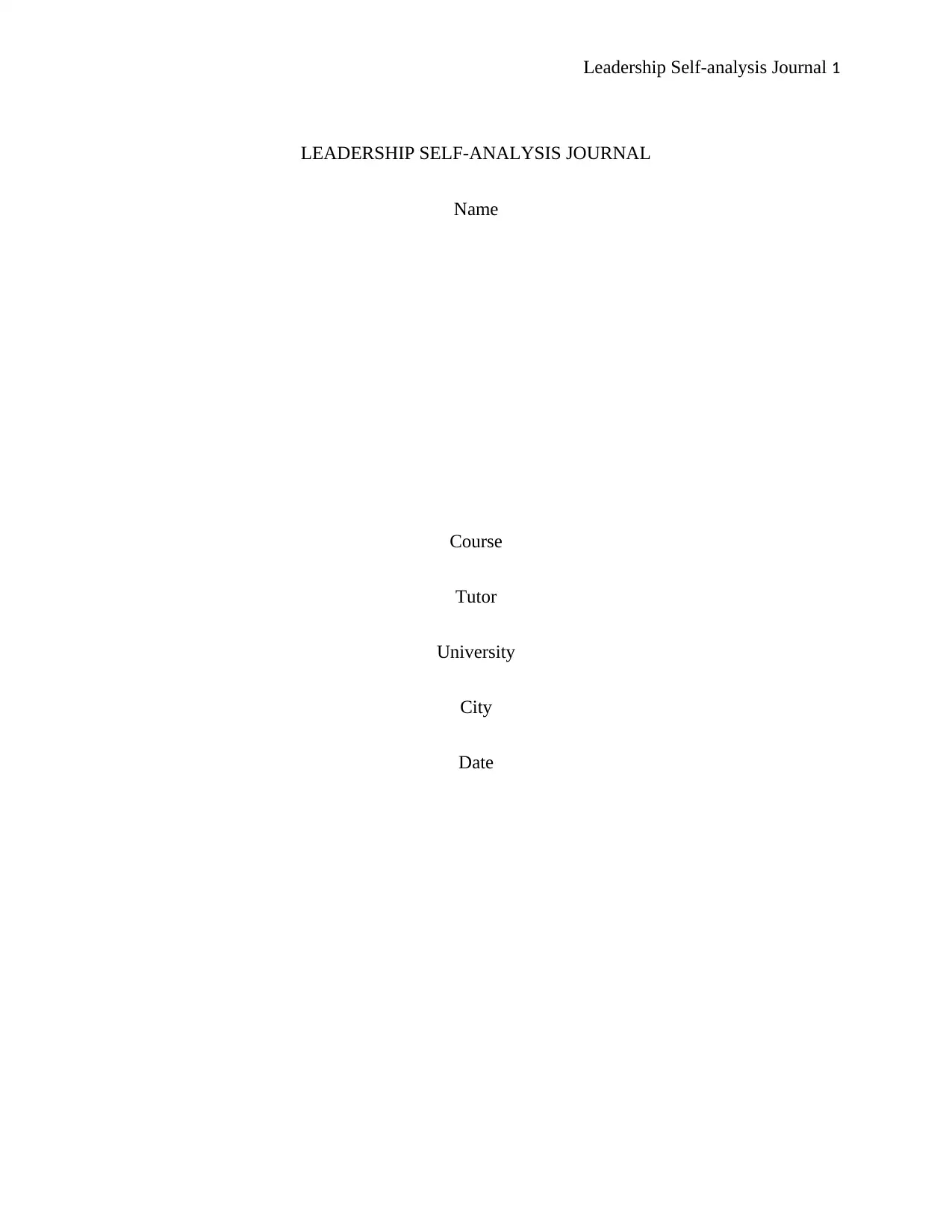
Leadership Self-analysis Journal 1
LEADERSHIP SELF-ANALYSIS JOURNAL
Name
Course
Tutor
University
City
Date
LEADERSHIP SELF-ANALYSIS JOURNAL
Name
Course
Tutor
University
City
Date
Secure Best Marks with AI Grader
Need help grading? Try our AI Grader for instant feedback on your assignments.
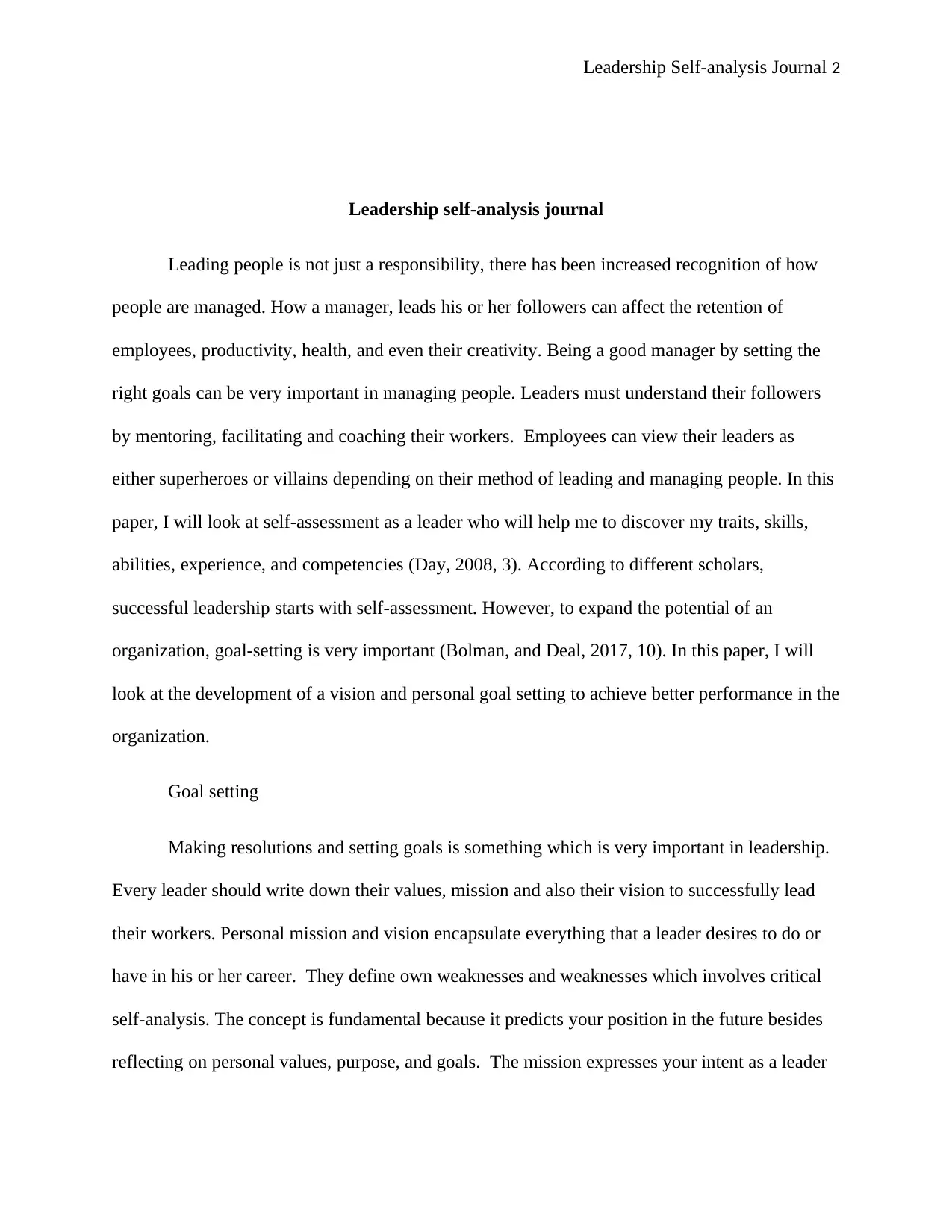
Leadership Self-analysis Journal 2
Leadership self-analysis journal
Leading people is not just a responsibility, there has been increased recognition of how
people are managed. How a manager, leads his or her followers can affect the retention of
employees, productivity, health, and even their creativity. Being a good manager by setting the
right goals can be very important in managing people. Leaders must understand their followers
by mentoring, facilitating and coaching their workers. Employees can view their leaders as
either superheroes or villains depending on their method of leading and managing people. In this
paper, I will look at self-assessment as a leader who will help me to discover my traits, skills,
abilities, experience, and competencies (Day, 2008, 3). According to different scholars,
successful leadership starts with self-assessment. However, to expand the potential of an
organization, goal-setting is very important (Bolman, and Deal, 2017, 10). In this paper, I will
look at the development of a vision and personal goal setting to achieve better performance in the
organization.
Goal setting
Making resolutions and setting goals is something which is very important in leadership.
Every leader should write down their values, mission and also their vision to successfully lead
their workers. Personal mission and vision encapsulate everything that a leader desires to do or
have in his or her career. They define own weaknesses and weaknesses which involves critical
self-analysis. The concept is fundamental because it predicts your position in the future besides
reflecting on personal values, purpose, and goals. The mission expresses your intent as a leader
Leadership self-analysis journal
Leading people is not just a responsibility, there has been increased recognition of how
people are managed. How a manager, leads his or her followers can affect the retention of
employees, productivity, health, and even their creativity. Being a good manager by setting the
right goals can be very important in managing people. Leaders must understand their followers
by mentoring, facilitating and coaching their workers. Employees can view their leaders as
either superheroes or villains depending on their method of leading and managing people. In this
paper, I will look at self-assessment as a leader who will help me to discover my traits, skills,
abilities, experience, and competencies (Day, 2008, 3). According to different scholars,
successful leadership starts with self-assessment. However, to expand the potential of an
organization, goal-setting is very important (Bolman, and Deal, 2017, 10). In this paper, I will
look at the development of a vision and personal goal setting to achieve better performance in the
organization.
Goal setting
Making resolutions and setting goals is something which is very important in leadership.
Every leader should write down their values, mission and also their vision to successfully lead
their workers. Personal mission and vision encapsulate everything that a leader desires to do or
have in his or her career. They define own weaknesses and weaknesses which involves critical
self-analysis. The concept is fundamental because it predicts your position in the future besides
reflecting on personal values, purpose, and goals. The mission expresses your intent as a leader

Leadership Self-analysis Journal 3
and guides you on how to achieve the desired goals (Gurley et al., 2015, 220). Let now look at
my vision, mission, and values.
Mission
The mission describes what I want to achieve as a leader and how I am going to attain my
goals (Cappelli et al., 2015, 12). The mission is all about what you are doing and how it will get
you to a better future. The purpose can either be in the form of a quote or a daily mantra which
helps you in returning during tough times. As a leader, I intend to apply ethical values, live a life
which is balanced and makes a difference in my organization. The goal is vital to me because it
helps me in realizing that leading others requires an understanding of myself and my role as a
leader. As a leader, having a life which is stable means that I should nurture my physical,
spiritual and academic aspects so that I can have a sense of self-esteem and well-being.
Vision
As described earlier in this paper, the view gives a prediction of my position in the future
and also reflects on personal values, purpose, and goals (Zhu, May, and Avolio, 2004, 18).
Developing a vision is not an easy task because I have to think of what I would like to achieve as
a manager, and how I want my followers to perceive me. I would like to be accountable and
enhance communication with my followers to create a friendly working environment. My vision
as a leader is to lead consistently with fairness, humility, integrity, and honest and transparent
communication. I also plan to develop and mentor my team while creating an enjoyable,
professional and respectful working environment (Mayfield, Mayfield, and Sharbrough, 2015,
98). Through this vision, I can achieve my goals by becoming a good leader who understands
what employees want.
and guides you on how to achieve the desired goals (Gurley et al., 2015, 220). Let now look at
my vision, mission, and values.
Mission
The mission describes what I want to achieve as a leader and how I am going to attain my
goals (Cappelli et al., 2015, 12). The mission is all about what you are doing and how it will get
you to a better future. The purpose can either be in the form of a quote or a daily mantra which
helps you in returning during tough times. As a leader, I intend to apply ethical values, live a life
which is balanced and makes a difference in my organization. The goal is vital to me because it
helps me in realizing that leading others requires an understanding of myself and my role as a
leader. As a leader, having a life which is stable means that I should nurture my physical,
spiritual and academic aspects so that I can have a sense of self-esteem and well-being.
Vision
As described earlier in this paper, the view gives a prediction of my position in the future
and also reflects on personal values, purpose, and goals (Zhu, May, and Avolio, 2004, 18).
Developing a vision is not an easy task because I have to think of what I would like to achieve as
a manager, and how I want my followers to perceive me. I would like to be accountable and
enhance communication with my followers to create a friendly working environment. My vision
as a leader is to lead consistently with fairness, humility, integrity, and honest and transparent
communication. I also plan to develop and mentor my team while creating an enjoyable,
professional and respectful working environment (Mayfield, Mayfield, and Sharbrough, 2015,
98). Through this vision, I can achieve my goals by becoming a good leader who understands
what employees want.

Leadership Self-analysis Journal 4
Values
Values are described as the guiding doctrines, and as a leader, I understand my ethics
very well. I know my weaknesses and strengths, and I even recognize the essence of having good
ethical behaviors. I must exhibit my ethics and core values in my actions and my leadership
style. Subordinates should see the ethics and ethics because you have to act by the morals all the
time. As a leader, I have my standards which include improving the quality of work and life
ethics of my subordinates and also influence my followers to become great co-workers or great
people in life. I want my followers to evolve in the workplace and also find it fun while working.
I will try to become the best leader, be kind, create happiness among my followers and also share
my skills with others so that they can become better than me.
Leadership practices
Leaders must have a clear mission, vision and values to help in the development of an
organization. However, as a leader, I have my weaknesses that may hinder my success, and I also
have strengths which help me to succeed (Kouzes, and Posner, 2016, 323). I can achieve all that
I want in the organization because I can effectively communicate with my followers although
sometimes I find it difficult to give constructive feedback to the followers. But I can improve in
such an area by consulting those who are close to me, and this will improve my success. I will
lead by example by having all the qualities of leadership, and this will help me in increasing my
strengths and eliminating my weaknesses.
First I will enhance my communication so that my followers can understand my
objectives, mission, and vision (Maxwell, 2007, 122). Through a contact, I can be able to give a
specific goal which all workers can understand. As a manager, I will also delegate my duties so
Values
Values are described as the guiding doctrines, and as a leader, I understand my ethics
very well. I know my weaknesses and strengths, and I even recognize the essence of having good
ethical behaviors. I must exhibit my ethics and core values in my actions and my leadership
style. Subordinates should see the ethics and ethics because you have to act by the morals all the
time. As a leader, I have my standards which include improving the quality of work and life
ethics of my subordinates and also influence my followers to become great co-workers or great
people in life. I want my followers to evolve in the workplace and also find it fun while working.
I will try to become the best leader, be kind, create happiness among my followers and also share
my skills with others so that they can become better than me.
Leadership practices
Leaders must have a clear mission, vision and values to help in the development of an
organization. However, as a leader, I have my weaknesses that may hinder my success, and I also
have strengths which help me to succeed (Kouzes, and Posner, 2016, 323). I can achieve all that
I want in the organization because I can effectively communicate with my followers although
sometimes I find it difficult to give constructive feedback to the followers. But I can improve in
such an area by consulting those who are close to me, and this will improve my success. I will
lead by example by having all the qualities of leadership, and this will help me in increasing my
strengths and eliminating my weaknesses.
First I will enhance my communication so that my followers can understand my
objectives, mission, and vision (Maxwell, 2007, 122). Through a contact, I can be able to give a
specific goal which all workers can understand. As a manager, I will also delegate my duties so
Secure Best Marks with AI Grader
Need help grading? Try our AI Grader for instant feedback on your assignments.
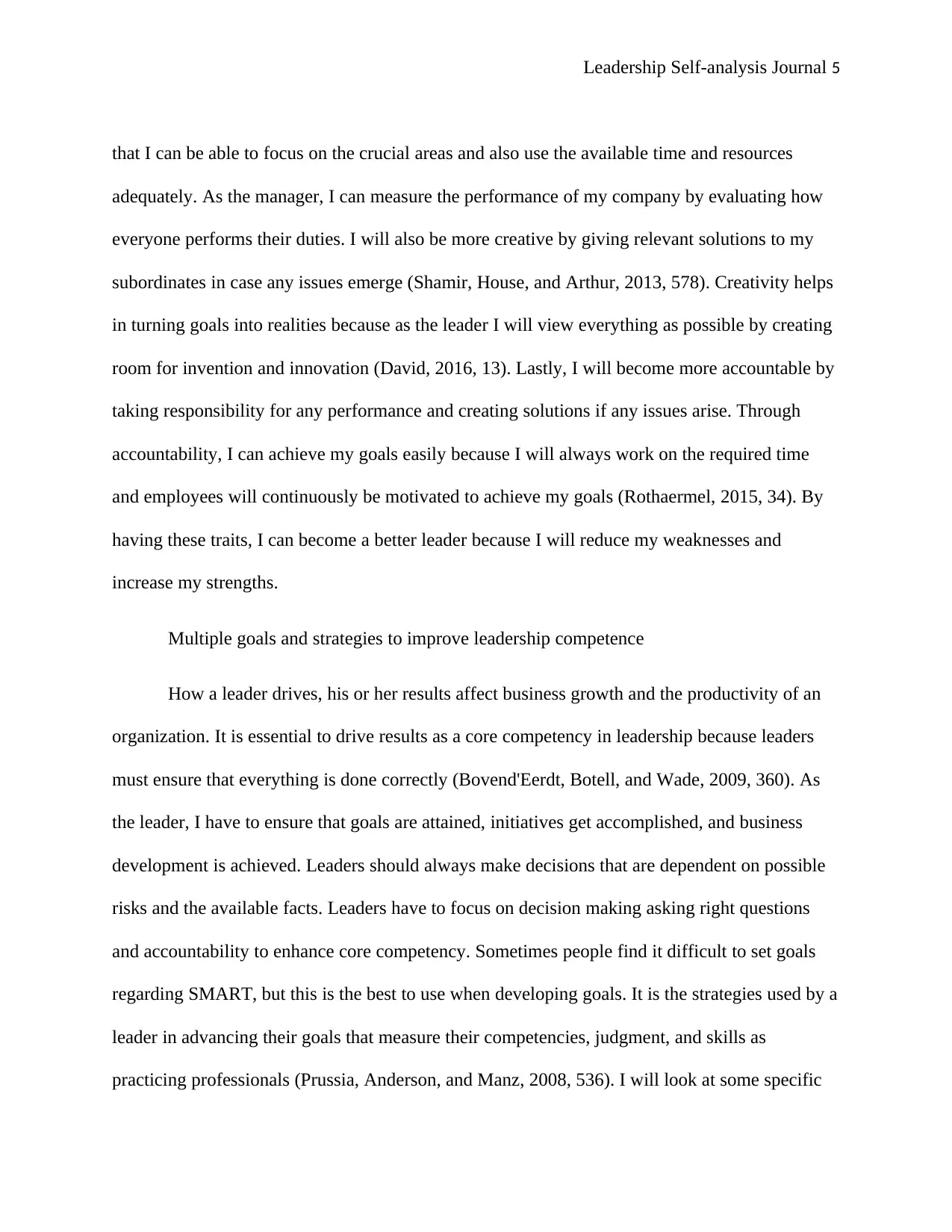
Leadership Self-analysis Journal 5
that I can be able to focus on the crucial areas and also use the available time and resources
adequately. As the manager, I can measure the performance of my company by evaluating how
everyone performs their duties. I will also be more creative by giving relevant solutions to my
subordinates in case any issues emerge (Shamir, House, and Arthur, 2013, 578). Creativity helps
in turning goals into realities because as the leader I will view everything as possible by creating
room for invention and innovation (David, 2016, 13). Lastly, I will become more accountable by
taking responsibility for any performance and creating solutions if any issues arise. Through
accountability, I can achieve my goals easily because I will always work on the required time
and employees will continuously be motivated to achieve my goals (Rothaermel, 2015, 34). By
having these traits, I can become a better leader because I will reduce my weaknesses and
increase my strengths.
Multiple goals and strategies to improve leadership competence
How a leader drives, his or her results affect business growth and the productivity of an
organization. It is essential to drive results as a core competency in leadership because leaders
must ensure that everything is done correctly (Bovend'Eerdt, Botell, and Wade, 2009, 360). As
the leader, I have to ensure that goals are attained, initiatives get accomplished, and business
development is achieved. Leaders should always make decisions that are dependent on possible
risks and the available facts. Leaders have to focus on decision making asking right questions
and accountability to enhance core competency. Sometimes people find it difficult to set goals
regarding SMART, but this is the best to use when developing goals. It is the strategies used by a
leader in advancing their goals that measure their competencies, judgment, and skills as
practicing professionals (Prussia, Anderson, and Manz, 2008, 536). I will look at some specific
that I can be able to focus on the crucial areas and also use the available time and resources
adequately. As the manager, I can measure the performance of my company by evaluating how
everyone performs their duties. I will also be more creative by giving relevant solutions to my
subordinates in case any issues emerge (Shamir, House, and Arthur, 2013, 578). Creativity helps
in turning goals into realities because as the leader I will view everything as possible by creating
room for invention and innovation (David, 2016, 13). Lastly, I will become more accountable by
taking responsibility for any performance and creating solutions if any issues arise. Through
accountability, I can achieve my goals easily because I will always work on the required time
and employees will continuously be motivated to achieve my goals (Rothaermel, 2015, 34). By
having these traits, I can become a better leader because I will reduce my weaknesses and
increase my strengths.
Multiple goals and strategies to improve leadership competence
How a leader drives, his or her results affect business growth and the productivity of an
organization. It is essential to drive results as a core competency in leadership because leaders
must ensure that everything is done correctly (Bovend'Eerdt, Botell, and Wade, 2009, 360). As
the leader, I have to ensure that goals are attained, initiatives get accomplished, and business
development is achieved. Leaders should always make decisions that are dependent on possible
risks and the available facts. Leaders have to focus on decision making asking right questions
and accountability to enhance core competency. Sometimes people find it difficult to set goals
regarding SMART, but this is the best to use when developing goals. It is the strategies used by a
leader in advancing their goals that measure their competencies, judgment, and skills as
practicing professionals (Prussia, Anderson, and Manz, 2008, 536). I will look at some specific
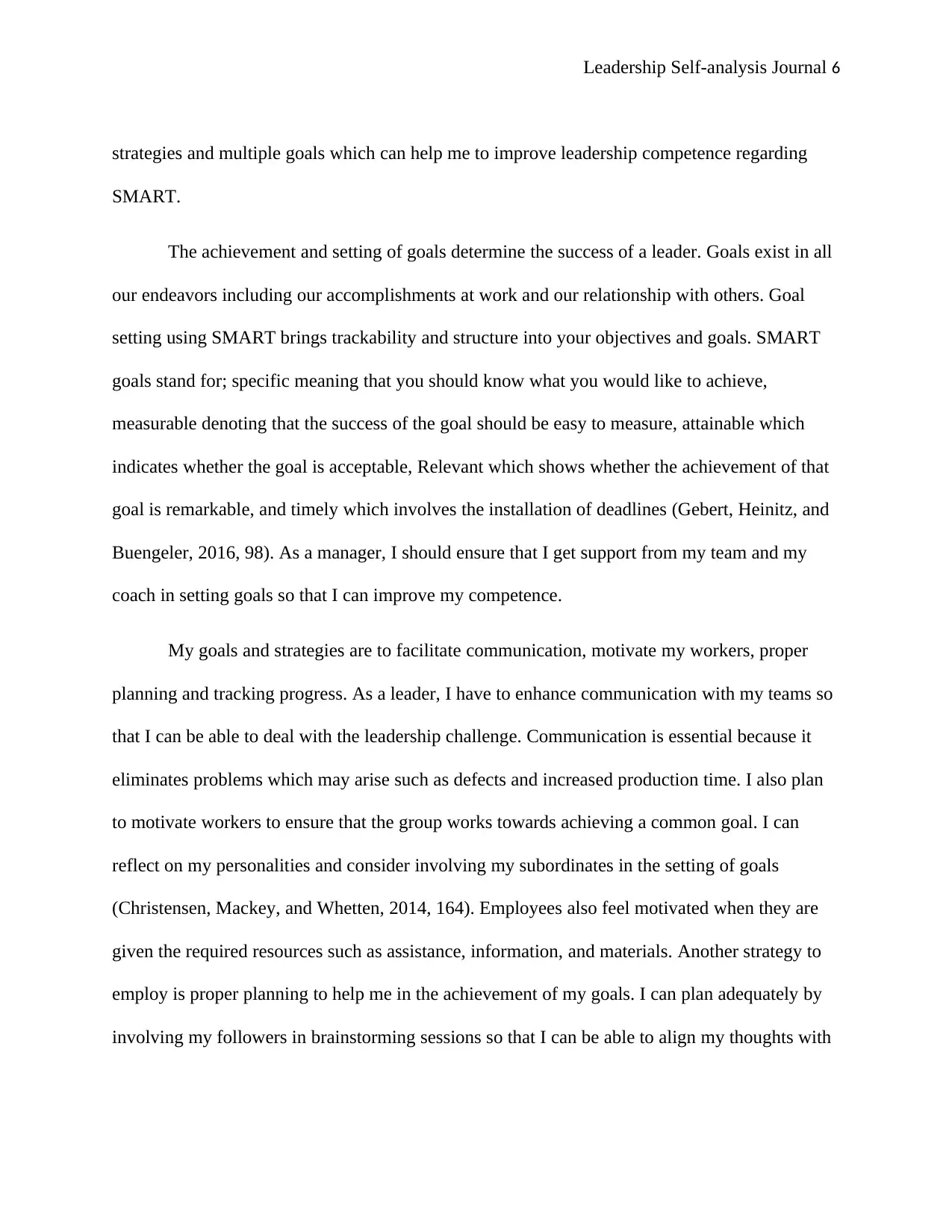
Leadership Self-analysis Journal 6
strategies and multiple goals which can help me to improve leadership competence regarding
SMART.
The achievement and setting of goals determine the success of a leader. Goals exist in all
our endeavors including our accomplishments at work and our relationship with others. Goal
setting using SMART brings trackability and structure into your objectives and goals. SMART
goals stand for; specific meaning that you should know what you would like to achieve,
measurable denoting that the success of the goal should be easy to measure, attainable which
indicates whether the goal is acceptable, Relevant which shows whether the achievement of that
goal is remarkable, and timely which involves the installation of deadlines (Gebert, Heinitz, and
Buengeler, 2016, 98). As a manager, I should ensure that I get support from my team and my
coach in setting goals so that I can improve my competence.
My goals and strategies are to facilitate communication, motivate my workers, proper
planning and tracking progress. As a leader, I have to enhance communication with my teams so
that I can be able to deal with the leadership challenge. Communication is essential because it
eliminates problems which may arise such as defects and increased production time. I also plan
to motivate workers to ensure that the group works towards achieving a common goal. I can
reflect on my personalities and consider involving my subordinates in the setting of goals
(Christensen, Mackey, and Whetten, 2014, 164). Employees also feel motivated when they are
given the required resources such as assistance, information, and materials. Another strategy to
employ is proper planning to help me in the achievement of my goals. I can plan adequately by
involving my followers in brainstorming sessions so that I can be able to align my thoughts with
strategies and multiple goals which can help me to improve leadership competence regarding
SMART.
The achievement and setting of goals determine the success of a leader. Goals exist in all
our endeavors including our accomplishments at work and our relationship with others. Goal
setting using SMART brings trackability and structure into your objectives and goals. SMART
goals stand for; specific meaning that you should know what you would like to achieve,
measurable denoting that the success of the goal should be easy to measure, attainable which
indicates whether the goal is acceptable, Relevant which shows whether the achievement of that
goal is remarkable, and timely which involves the installation of deadlines (Gebert, Heinitz, and
Buengeler, 2016, 98). As a manager, I should ensure that I get support from my team and my
coach in setting goals so that I can improve my competence.
My goals and strategies are to facilitate communication, motivate my workers, proper
planning and tracking progress. As a leader, I have to enhance communication with my teams so
that I can be able to deal with the leadership challenge. Communication is essential because it
eliminates problems which may arise such as defects and increased production time. I also plan
to motivate workers to ensure that the group works towards achieving a common goal. I can
reflect on my personalities and consider involving my subordinates in the setting of goals
(Christensen, Mackey, and Whetten, 2014, 164). Employees also feel motivated when they are
given the required resources such as assistance, information, and materials. Another strategy to
employ is proper planning to help me in the achievement of my goals. I can plan adequately by
involving my followers in brainstorming sessions so that I can be able to align my thoughts with
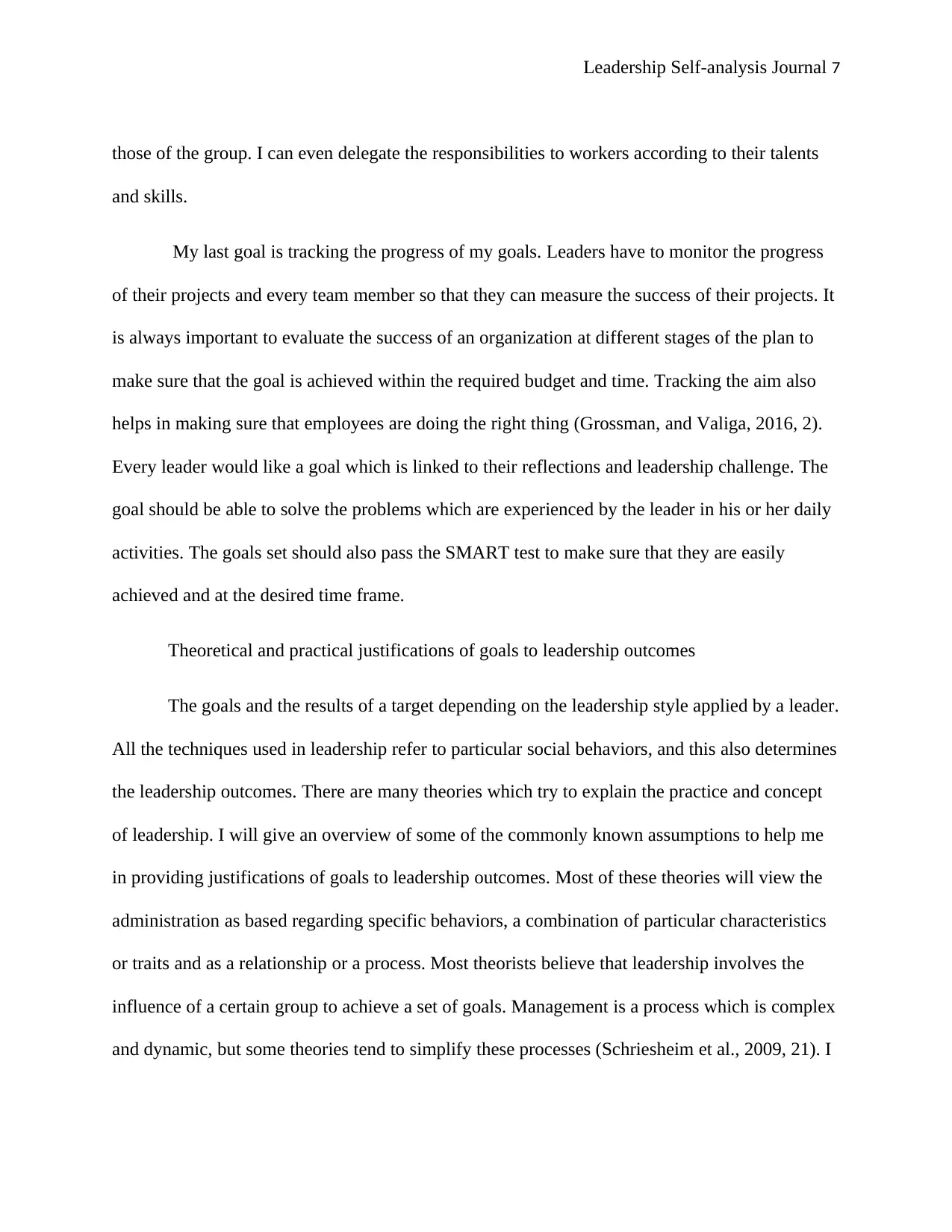
Leadership Self-analysis Journal 7
those of the group. I can even delegate the responsibilities to workers according to their talents
and skills.
My last goal is tracking the progress of my goals. Leaders have to monitor the progress
of their projects and every team member so that they can measure the success of their projects. It
is always important to evaluate the success of an organization at different stages of the plan to
make sure that the goal is achieved within the required budget and time. Tracking the aim also
helps in making sure that employees are doing the right thing (Grossman, and Valiga, 2016, 2).
Every leader would like a goal which is linked to their reflections and leadership challenge. The
goal should be able to solve the problems which are experienced by the leader in his or her daily
activities. The goals set should also pass the SMART test to make sure that they are easily
achieved and at the desired time frame.
Theoretical and practical justifications of goals to leadership outcomes
The goals and the results of a target depending on the leadership style applied by a leader.
All the techniques used in leadership refer to particular social behaviors, and this also determines
the leadership outcomes. There are many theories which try to explain the practice and concept
of leadership. I will give an overview of some of the commonly known assumptions to help me
in providing justifications of goals to leadership outcomes. Most of these theories will view the
administration as based regarding specific behaviors, a combination of particular characteristics
or traits and as a relationship or a process. Most theorists believe that leadership involves the
influence of a certain group to achieve a set of goals. Management is a process which is complex
and dynamic, but some theories tend to simplify these processes (Schriesheim et al., 2009, 21). I
those of the group. I can even delegate the responsibilities to workers according to their talents
and skills.
My last goal is tracking the progress of my goals. Leaders have to monitor the progress
of their projects and every team member so that they can measure the success of their projects. It
is always important to evaluate the success of an organization at different stages of the plan to
make sure that the goal is achieved within the required budget and time. Tracking the aim also
helps in making sure that employees are doing the right thing (Grossman, and Valiga, 2016, 2).
Every leader would like a goal which is linked to their reflections and leadership challenge. The
goal should be able to solve the problems which are experienced by the leader in his or her daily
activities. The goals set should also pass the SMART test to make sure that they are easily
achieved and at the desired time frame.
Theoretical and practical justifications of goals to leadership outcomes
The goals and the results of a target depending on the leadership style applied by a leader.
All the techniques used in leadership refer to particular social behaviors, and this also determines
the leadership outcomes. There are many theories which try to explain the practice and concept
of leadership. I will give an overview of some of the commonly known assumptions to help me
in providing justifications of goals to leadership outcomes. Most of these theories will view the
administration as based regarding specific behaviors, a combination of particular characteristics
or traits and as a relationship or a process. Most theorists believe that leadership involves the
influence of a certain group to achieve a set of goals. Management is a process which is complex
and dynamic, but some theories tend to simplify these processes (Schriesheim et al., 2009, 21). I
Paraphrase This Document
Need a fresh take? Get an instant paraphrase of this document with our AI Paraphraser
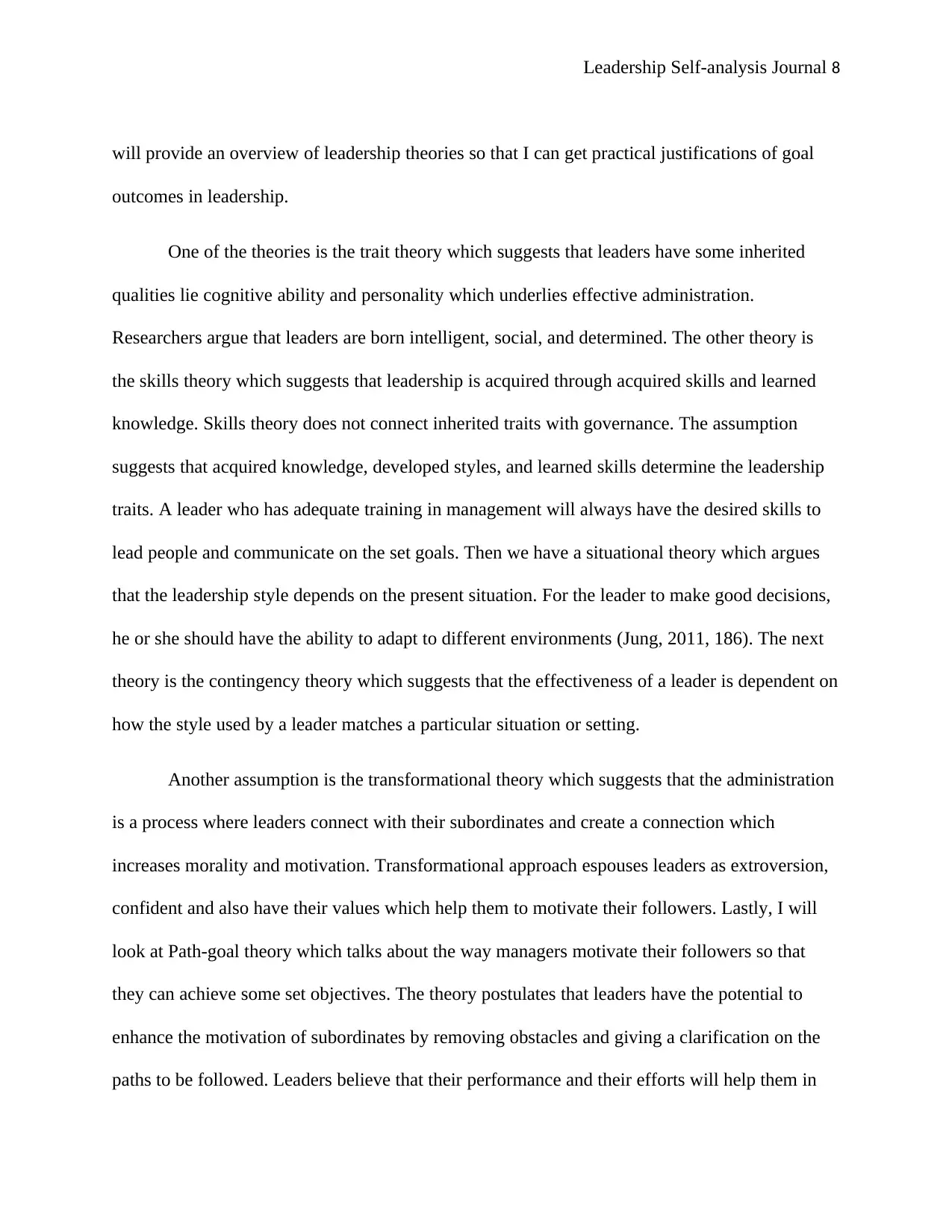
Leadership Self-analysis Journal 8
will provide an overview of leadership theories so that I can get practical justifications of goal
outcomes in leadership.
One of the theories is the trait theory which suggests that leaders have some inherited
qualities lie cognitive ability and personality which underlies effective administration.
Researchers argue that leaders are born intelligent, social, and determined. The other theory is
the skills theory which suggests that leadership is acquired through acquired skills and learned
knowledge. Skills theory does not connect inherited traits with governance. The assumption
suggests that acquired knowledge, developed styles, and learned skills determine the leadership
traits. A leader who has adequate training in management will always have the desired skills to
lead people and communicate on the set goals. Then we have a situational theory which argues
that the leadership style depends on the present situation. For the leader to make good decisions,
he or she should have the ability to adapt to different environments (Jung, 2011, 186). The next
theory is the contingency theory which suggests that the effectiveness of a leader is dependent on
how the style used by a leader matches a particular situation or setting.
Another assumption is the transformational theory which suggests that the administration
is a process where leaders connect with their subordinates and create a connection which
increases morality and motivation. Transformational approach espouses leaders as extroversion,
confident and also have their values which help them to motivate their followers. Lastly, I will
look at Path-goal theory which talks about the way managers motivate their followers so that
they can achieve some set objectives. The theory postulates that leaders have the potential to
enhance the motivation of subordinates by removing obstacles and giving a clarification on the
paths to be followed. Leaders believe that their performance and their efforts will help them in
will provide an overview of leadership theories so that I can get practical justifications of goal
outcomes in leadership.
One of the theories is the trait theory which suggests that leaders have some inherited
qualities lie cognitive ability and personality which underlies effective administration.
Researchers argue that leaders are born intelligent, social, and determined. The other theory is
the skills theory which suggests that leadership is acquired through acquired skills and learned
knowledge. Skills theory does not connect inherited traits with governance. The assumption
suggests that acquired knowledge, developed styles, and learned skills determine the leadership
traits. A leader who has adequate training in management will always have the desired skills to
lead people and communicate on the set goals. Then we have a situational theory which argues
that the leadership style depends on the present situation. For the leader to make good decisions,
he or she should have the ability to adapt to different environments (Jung, 2011, 186). The next
theory is the contingency theory which suggests that the effectiveness of a leader is dependent on
how the style used by a leader matches a particular situation or setting.
Another assumption is the transformational theory which suggests that the administration
is a process where leaders connect with their subordinates and create a connection which
increases morality and motivation. Transformational approach espouses leaders as extroversion,
confident and also have their values which help them to motivate their followers. Lastly, I will
look at Path-goal theory which talks about the way managers motivate their followers so that
they can achieve some set objectives. The theory postulates that leaders have the potential to
enhance the motivation of subordinates by removing obstacles and giving a clarification on the
paths to be followed. Leaders believe that their performance and their efforts will help them in
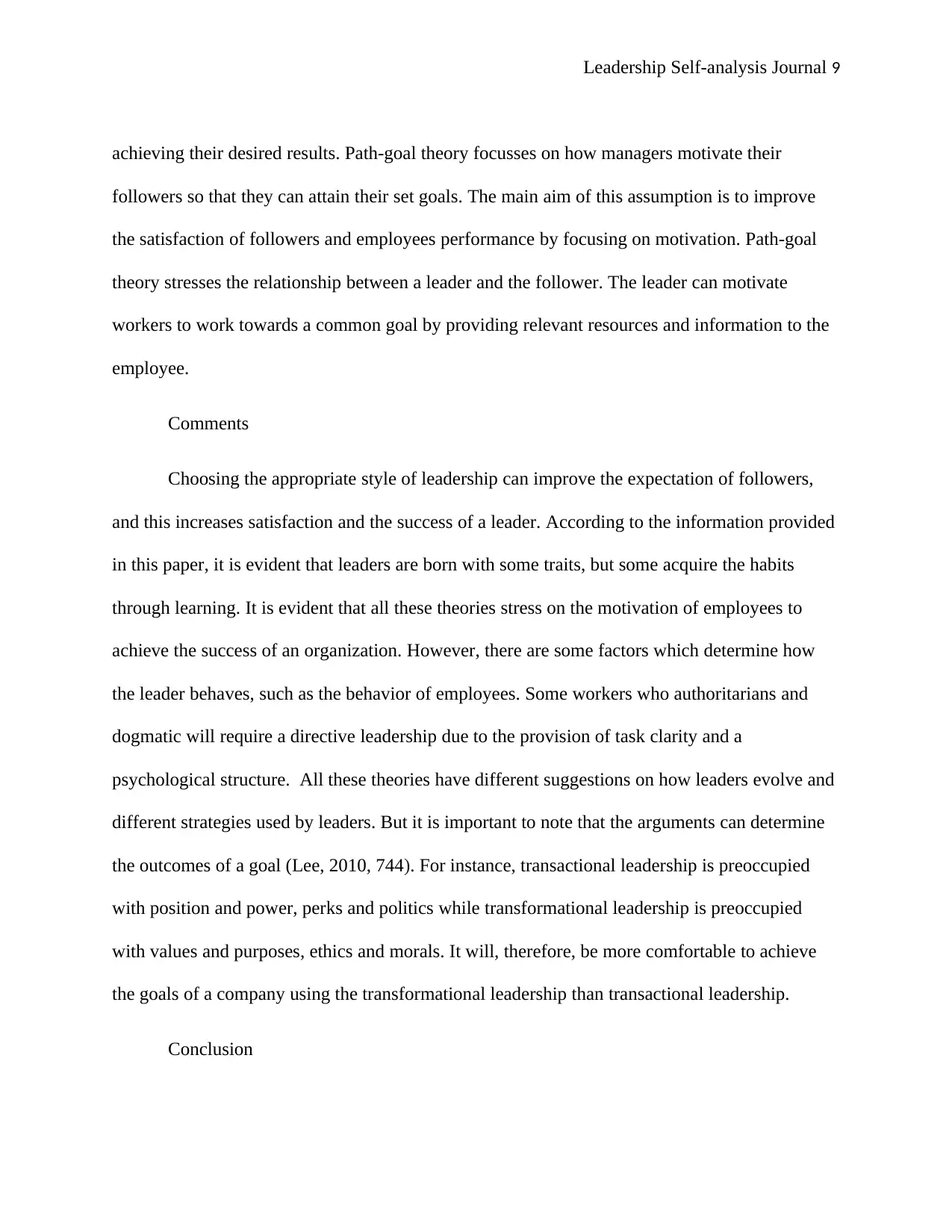
Leadership Self-analysis Journal 9
achieving their desired results. Path-goal theory focusses on how managers motivate their
followers so that they can attain their set goals. The main aim of this assumption is to improve
the satisfaction of followers and employees performance by focusing on motivation. Path-goal
theory stresses the relationship between a leader and the follower. The leader can motivate
workers to work towards a common goal by providing relevant resources and information to the
employee.
Comments
Choosing the appropriate style of leadership can improve the expectation of followers,
and this increases satisfaction and the success of a leader. According to the information provided
in this paper, it is evident that leaders are born with some traits, but some acquire the habits
through learning. It is evident that all these theories stress on the motivation of employees to
achieve the success of an organization. However, there are some factors which determine how
the leader behaves, such as the behavior of employees. Some workers who authoritarians and
dogmatic will require a directive leadership due to the provision of task clarity and a
psychological structure. All these theories have different suggestions on how leaders evolve and
different strategies used by leaders. But it is important to note that the arguments can determine
the outcomes of a goal (Lee, 2010, 744). For instance, transactional leadership is preoccupied
with position and power, perks and politics while transformational leadership is preoccupied
with values and purposes, ethics and morals. It will, therefore, be more comfortable to achieve
the goals of a company using the transformational leadership than transactional leadership.
Conclusion
achieving their desired results. Path-goal theory focusses on how managers motivate their
followers so that they can attain their set goals. The main aim of this assumption is to improve
the satisfaction of followers and employees performance by focusing on motivation. Path-goal
theory stresses the relationship between a leader and the follower. The leader can motivate
workers to work towards a common goal by providing relevant resources and information to the
employee.
Comments
Choosing the appropriate style of leadership can improve the expectation of followers,
and this increases satisfaction and the success of a leader. According to the information provided
in this paper, it is evident that leaders are born with some traits, but some acquire the habits
through learning. It is evident that all these theories stress on the motivation of employees to
achieve the success of an organization. However, there are some factors which determine how
the leader behaves, such as the behavior of employees. Some workers who authoritarians and
dogmatic will require a directive leadership due to the provision of task clarity and a
psychological structure. All these theories have different suggestions on how leaders evolve and
different strategies used by leaders. But it is important to note that the arguments can determine
the outcomes of a goal (Lee, 2010, 744). For instance, transactional leadership is preoccupied
with position and power, perks and politics while transformational leadership is preoccupied
with values and purposes, ethics and morals. It will, therefore, be more comfortable to achieve
the goals of a company using the transformational leadership than transactional leadership.
Conclusion
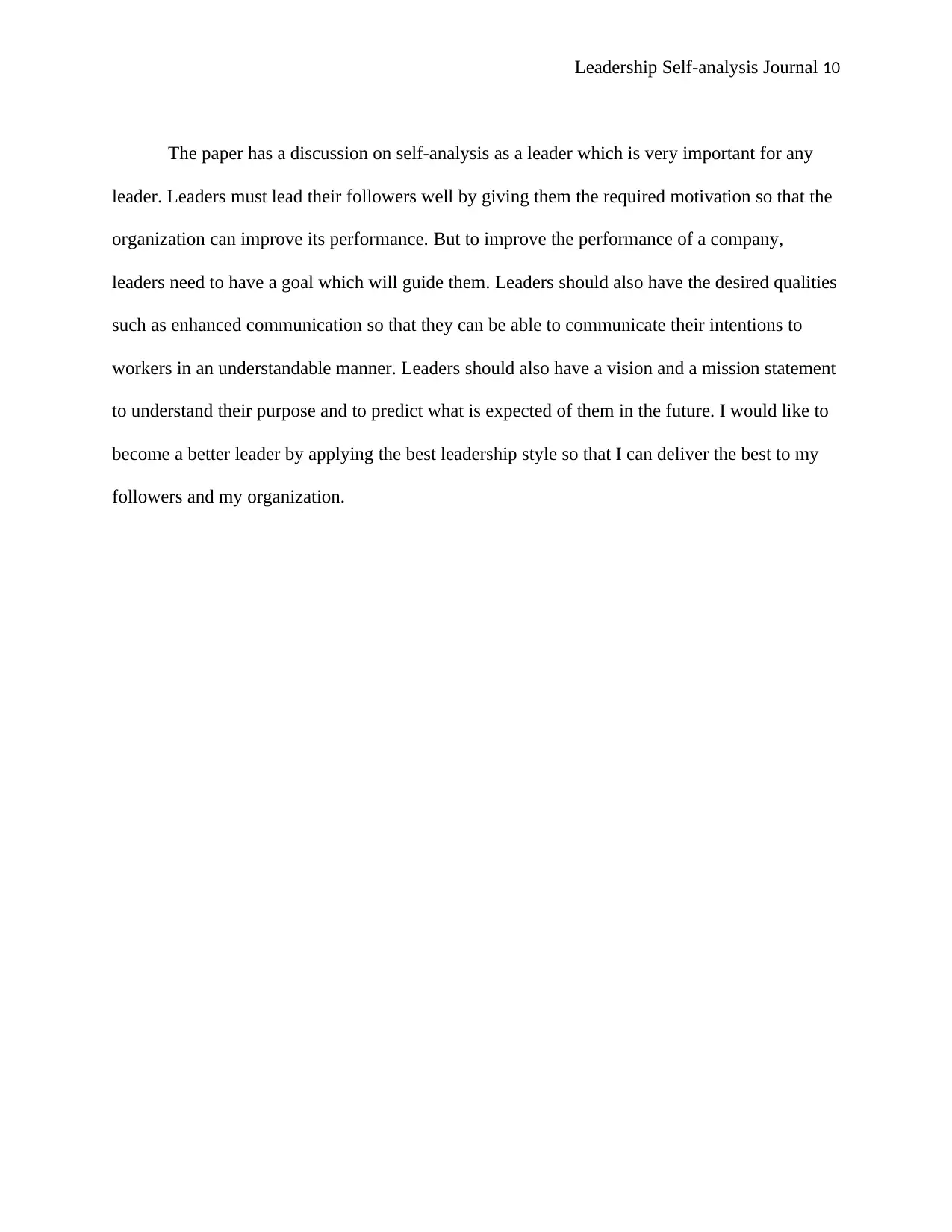
Leadership Self-analysis Journal 10
The paper has a discussion on self-analysis as a leader which is very important for any
leader. Leaders must lead their followers well by giving them the required motivation so that the
organization can improve its performance. But to improve the performance of a company,
leaders need to have a goal which will guide them. Leaders should also have the desired qualities
such as enhanced communication so that they can be able to communicate their intentions to
workers in an understandable manner. Leaders should also have a vision and a mission statement
to understand their purpose and to predict what is expected of them in the future. I would like to
become a better leader by applying the best leadership style so that I can deliver the best to my
followers and my organization.
The paper has a discussion on self-analysis as a leader which is very important for any
leader. Leaders must lead their followers well by giving them the required motivation so that the
organization can improve its performance. But to improve the performance of a company,
leaders need to have a goal which will guide them. Leaders should also have the desired qualities
such as enhanced communication so that they can be able to communicate their intentions to
workers in an understandable manner. Leaders should also have a vision and a mission statement
to understand their purpose and to predict what is expected of them in the future. I would like to
become a better leader by applying the best leadership style so that I can deliver the best to my
followers and my organization.
Secure Best Marks with AI Grader
Need help grading? Try our AI Grader for instant feedback on your assignments.
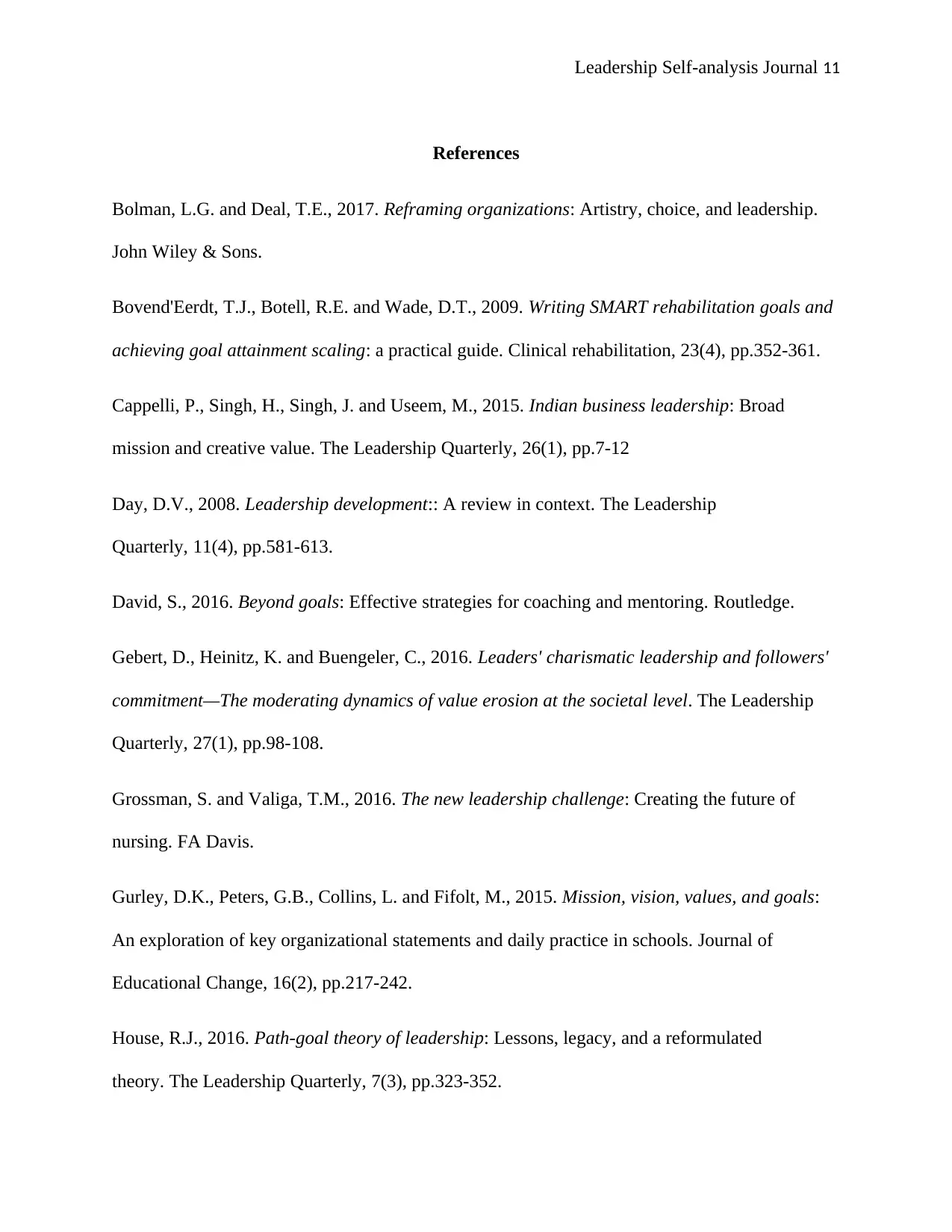
Leadership Self-analysis Journal 11
References
Bolman, L.G. and Deal, T.E., 2017. Reframing organizations: Artistry, choice, and leadership.
John Wiley & Sons.
Bovend'Eerdt, T.J., Botell, R.E. and Wade, D.T., 2009. Writing SMART rehabilitation goals and
achieving goal attainment scaling: a practical guide. Clinical rehabilitation, 23(4), pp.352-361.
Cappelli, P., Singh, H., Singh, J. and Useem, M., 2015. Indian business leadership: Broad
mission and creative value. The Leadership Quarterly, 26(1), pp.7-12
Day, D.V., 2008. Leadership development:: A review in context. The Leadership
Quarterly, 11(4), pp.581-613.
David, S., 2016. Beyond goals: Effective strategies for coaching and mentoring. Routledge.
Gebert, D., Heinitz, K. and Buengeler, C., 2016. Leaders' charismatic leadership and followers'
commitment—The moderating dynamics of value erosion at the societal level. The Leadership
Quarterly, 27(1), pp.98-108.
Grossman, S. and Valiga, T.M., 2016. The new leadership challenge: Creating the future of
nursing. FA Davis.
Gurley, D.K., Peters, G.B., Collins, L. and Fifolt, M., 2015. Mission, vision, values, and goals:
An exploration of key organizational statements and daily practice in schools. Journal of
Educational Change, 16(2), pp.217-242.
House, R.J., 2016. Path-goal theory of leadership: Lessons, legacy, and a reformulated
theory. The Leadership Quarterly, 7(3), pp.323-352.
References
Bolman, L.G. and Deal, T.E., 2017. Reframing organizations: Artistry, choice, and leadership.
John Wiley & Sons.
Bovend'Eerdt, T.J., Botell, R.E. and Wade, D.T., 2009. Writing SMART rehabilitation goals and
achieving goal attainment scaling: a practical guide. Clinical rehabilitation, 23(4), pp.352-361.
Cappelli, P., Singh, H., Singh, J. and Useem, M., 2015. Indian business leadership: Broad
mission and creative value. The Leadership Quarterly, 26(1), pp.7-12
Day, D.V., 2008. Leadership development:: A review in context. The Leadership
Quarterly, 11(4), pp.581-613.
David, S., 2016. Beyond goals: Effective strategies for coaching and mentoring. Routledge.
Gebert, D., Heinitz, K. and Buengeler, C., 2016. Leaders' charismatic leadership and followers'
commitment—The moderating dynamics of value erosion at the societal level. The Leadership
Quarterly, 27(1), pp.98-108.
Grossman, S. and Valiga, T.M., 2016. The new leadership challenge: Creating the future of
nursing. FA Davis.
Gurley, D.K., Peters, G.B., Collins, L. and Fifolt, M., 2015. Mission, vision, values, and goals:
An exploration of key organizational statements and daily practice in schools. Journal of
Educational Change, 16(2), pp.217-242.
House, R.J., 2016. Path-goal theory of leadership: Lessons, legacy, and a reformulated
theory. The Leadership Quarterly, 7(3), pp.323-352.
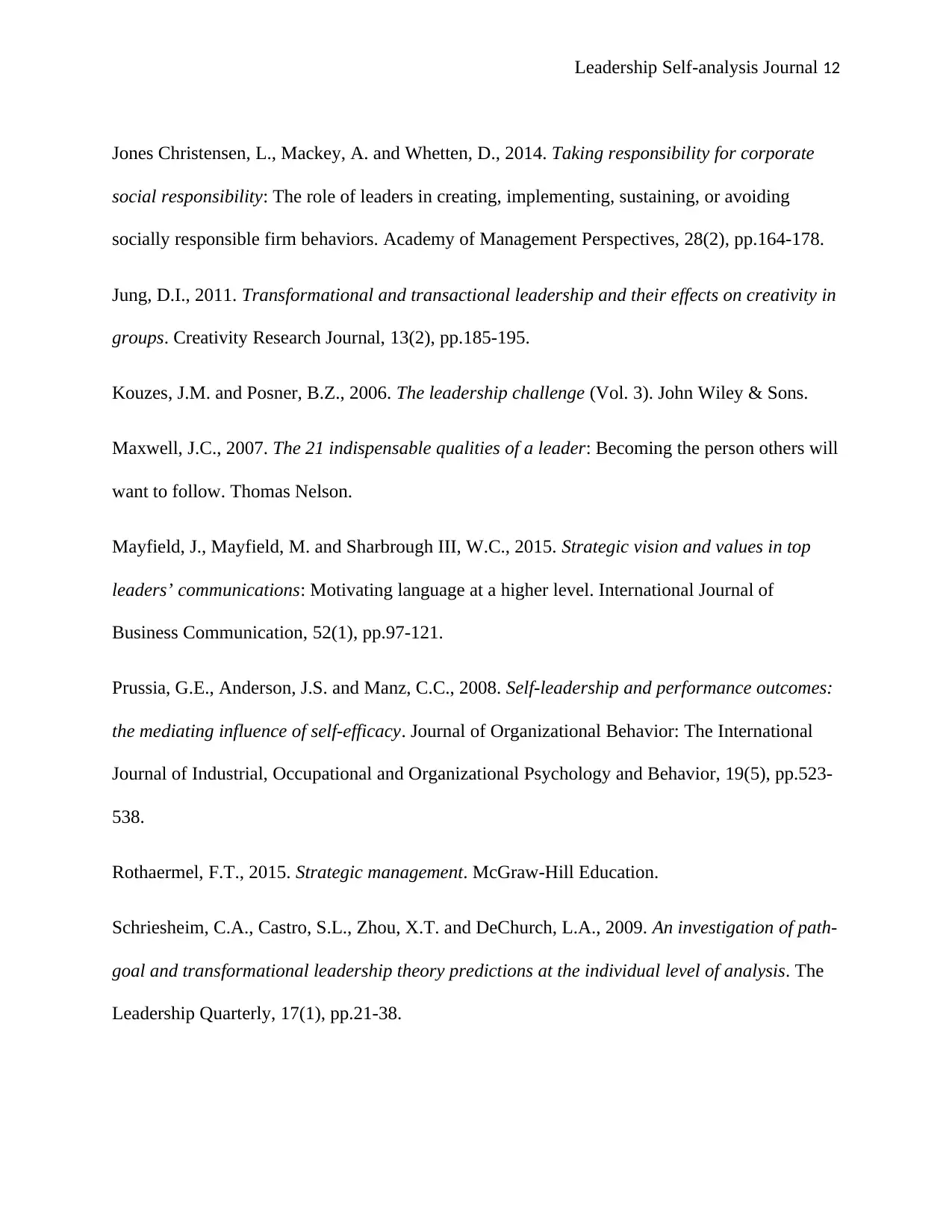
Leadership Self-analysis Journal 12
Jones Christensen, L., Mackey, A. and Whetten, D., 2014. Taking responsibility for corporate
social responsibility: The role of leaders in creating, implementing, sustaining, or avoiding
socially responsible firm behaviors. Academy of Management Perspectives, 28(2), pp.164-178.
Jung, D.I., 2011. Transformational and transactional leadership and their effects on creativity in
groups. Creativity Research Journal, 13(2), pp.185-195.
Kouzes, J.M. and Posner, B.Z., 2006. The leadership challenge (Vol. 3). John Wiley & Sons.
Maxwell, J.C., 2007. The 21 indispensable qualities of a leader: Becoming the person others will
want to follow. Thomas Nelson.
Mayfield, J., Mayfield, M. and Sharbrough III, W.C., 2015. Strategic vision and values in top
leaders’ communications: Motivating language at a higher level. International Journal of
Business Communication, 52(1), pp.97-121.
Prussia, G.E., Anderson, J.S. and Manz, C.C., 2008. Self‐leadership and performance outcomes:
the mediating influence of self‐efficacy. Journal of Organizational Behavior: The International
Journal of Industrial, Occupational and Organizational Psychology and Behavior, 19(5), pp.523-
538.
Rothaermel, F.T., 2015. Strategic management. McGraw-Hill Education.
Schriesheim, C.A., Castro, S.L., Zhou, X.T. and DeChurch, L.A., 2009. An investigation of path-
goal and transformational leadership theory predictions at the individual level of analysis. The
Leadership Quarterly, 17(1), pp.21-38.
Jones Christensen, L., Mackey, A. and Whetten, D., 2014. Taking responsibility for corporate
social responsibility: The role of leaders in creating, implementing, sustaining, or avoiding
socially responsible firm behaviors. Academy of Management Perspectives, 28(2), pp.164-178.
Jung, D.I., 2011. Transformational and transactional leadership and their effects on creativity in
groups. Creativity Research Journal, 13(2), pp.185-195.
Kouzes, J.M. and Posner, B.Z., 2006. The leadership challenge (Vol. 3). John Wiley & Sons.
Maxwell, J.C., 2007. The 21 indispensable qualities of a leader: Becoming the person others will
want to follow. Thomas Nelson.
Mayfield, J., Mayfield, M. and Sharbrough III, W.C., 2015. Strategic vision and values in top
leaders’ communications: Motivating language at a higher level. International Journal of
Business Communication, 52(1), pp.97-121.
Prussia, G.E., Anderson, J.S. and Manz, C.C., 2008. Self‐leadership and performance outcomes:
the mediating influence of self‐efficacy. Journal of Organizational Behavior: The International
Journal of Industrial, Occupational and Organizational Psychology and Behavior, 19(5), pp.523-
538.
Rothaermel, F.T., 2015. Strategic management. McGraw-Hill Education.
Schriesheim, C.A., Castro, S.L., Zhou, X.T. and DeChurch, L.A., 2009. An investigation of path-
goal and transformational leadership theory predictions at the individual level of analysis. The
Leadership Quarterly, 17(1), pp.21-38.
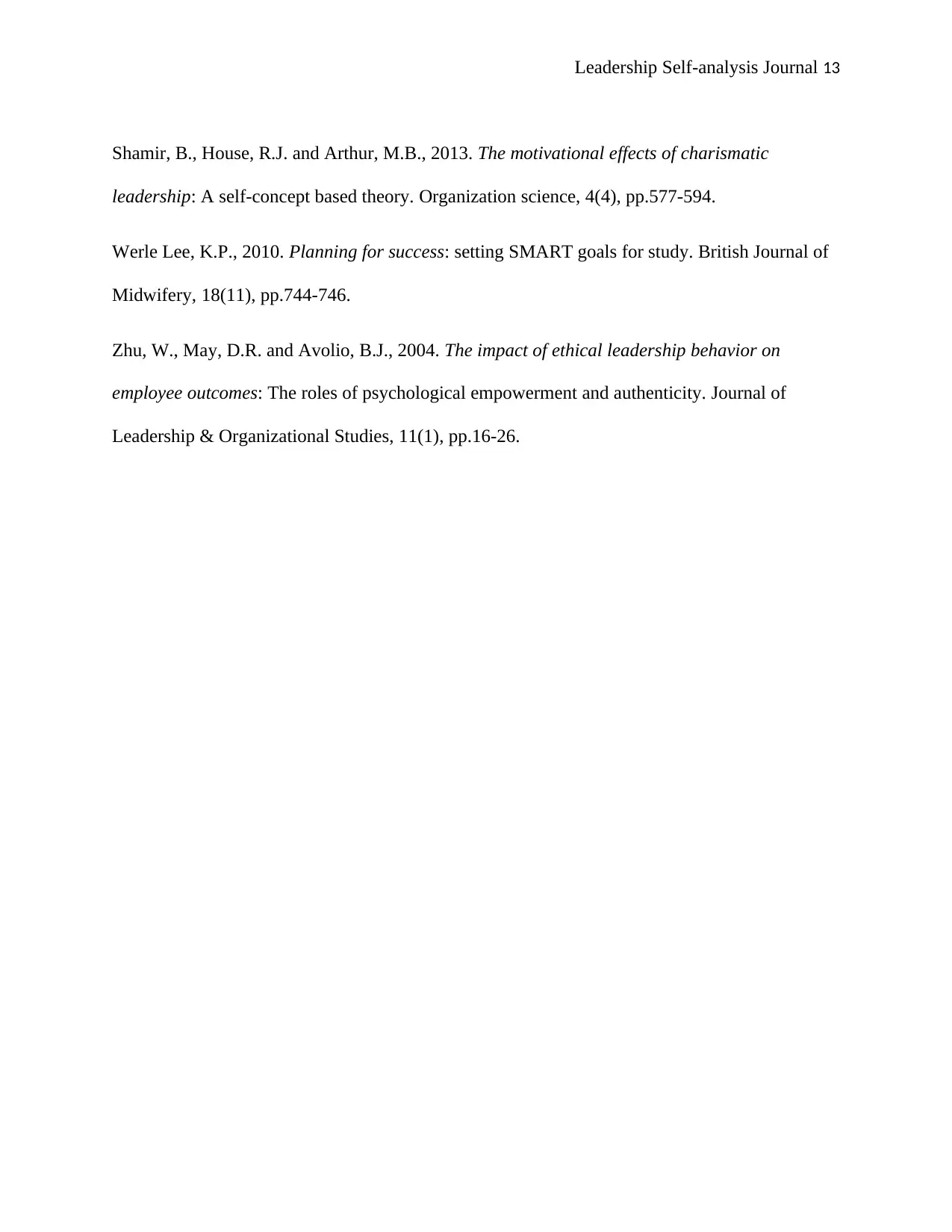
Leadership Self-analysis Journal 13
Shamir, B., House, R.J. and Arthur, M.B., 2013. The motivational effects of charismatic
leadership: A self-concept based theory. Organization science, 4(4), pp.577-594.
Werle Lee, K.P., 2010. Planning for success: setting SMART goals for study. British Journal of
Midwifery, 18(11), pp.744-746.
Zhu, W., May, D.R. and Avolio, B.J., 2004. The impact of ethical leadership behavior on
employee outcomes: The roles of psychological empowerment and authenticity. Journal of
Leadership & Organizational Studies, 11(1), pp.16-26.
Shamir, B., House, R.J. and Arthur, M.B., 2013. The motivational effects of charismatic
leadership: A self-concept based theory. Organization science, 4(4), pp.577-594.
Werle Lee, K.P., 2010. Planning for success: setting SMART goals for study. British Journal of
Midwifery, 18(11), pp.744-746.
Zhu, W., May, D.R. and Avolio, B.J., 2004. The impact of ethical leadership behavior on
employee outcomes: The roles of psychological empowerment and authenticity. Journal of
Leadership & Organizational Studies, 11(1), pp.16-26.
1 out of 13
Related Documents
Your All-in-One AI-Powered Toolkit for Academic Success.
+13062052269
info@desklib.com
Available 24*7 on WhatsApp / Email
![[object Object]](/_next/static/media/star-bottom.7253800d.svg)
Unlock your academic potential
© 2024 | Zucol Services PVT LTD | All rights reserved.





